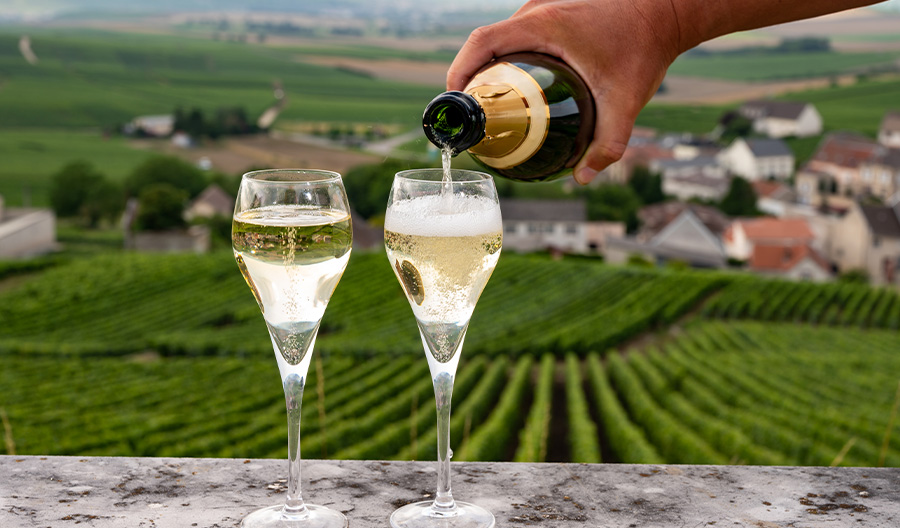At one time, common wisdom dictated that Champagne was for special occasions—holidays, birthdays, engagement parties, and other festive celebrations worthy of a toast. Between 2019 and 2023, the number of American drinkers enjoying sparkling wine has increased by 30%, according to an International Wine and Spirits Research report, and that growth is forecast to continue. In the same report, projections suggest that the market volume for sparkling wine will grow by more than 15% between 2021 and 2026. The big takeaway? Expect to see more folks in the U.S. drinking more bubbly, more often.
Most sparkling lovers these days have a particular fondness for dry styles—a contrast to the sweet Champagnes popular in the 19th century. But often, labels don’t make it easy to decipher what’s dry and what’s not. Words like “brut” and “extra brut” may leave some consumers scratching their heads. Here’s everything you need to know.
What Is Brut Champagne?
To make Champagne, which is a sparkling wine specifically made in Champagne, France, winemakers use a technique called the traditional method. Through this technique, the wine undergoes a second fermentation in the bottle and spends time in contact with the lees—dead yeast cells—which creates a sparkling wine with a rounded body and creamy, nutty, and toasty notes. During the final stage of Champagne production, winemakers will add a sweet element (usually sugar or a tincture of wine and sugar) known as dosage to balance out the acidity. The wine is considered “brut” if the finished Champagne has anywhere between zero and 12 grams per liter of residual sugar.
“‘Brut’ technically defines a certain dosage. But there’s more to it than that. It is often used to describe a traditional blend cuvée that forms the core and entry point to a range of wines a Champagne house produces.
Brut, which includes reds, whites and rosé, is the most popular category of dry sparkling wine. However, it’s not the driest. Beyond brut, Champagne with zero to six grams per liter of residual sugar can be labeled extra brut, and if a sparkling wine has less than three grams per liter of residual sugar, it is labeled brut nature or zero dosage. These labeling requirements are also used beyond Champagne: Wineries in other areas of France, the U.S., Italy, Spain and other global wine regions follow the same labeling guidelines for brut.
Determining the right dosage to create a balanced brut wine is an artform. For example, a wine with lower acidity only needs a small dosage. Also, the longer a wine ages on the lees, the creamier it becomes, which can also impact dosage decisions.
The level of dosage added to find the right balance varies from wine to wine. Making a brut sparkling wine starts with the viticulture” To retain higher acidity, grapes destined for brut sparkling wines are typically picked earlier than the fruit used for still wines. These decisions influence what happens in the winery after that.The most crucial factor to remember about brut sparkling is that it will not have any perceived sweetness to it.

What Is the Difference Between Brut and Extra Dry?
Sometimes, you may come across a bottle that doesn’t say “brut” at all, but rather “extra dry.” Don’t be fooled by the play on words.
One would think that ‘extra dry’ means ‘extra brut.' But the technical definition of ‘extra dry’ is actually anywhere from 12 to 17 grams per liter of residual sugar. So it’s actually less dry than brut, even though it’s called ‘extra dry.’
Although still considered a dry style of sparkling wine, extra dry wines can be perceived as sweet on the palate. They tend to exude richer characteristics and more body than brut sparkling wines.
What Makes a Good Brut Champagne?
Although “brut” can indicate the dryness of sparkling wine, the word alone can’t convey its quality. Finding the best one for your palate can take some experimenting.
There are plenty of excellent examples of quality brut Champagne from notable legacy labels. Try looking for brut sparklers from other regions of France like Alsace and the U.S. or try brut styles of Italian Prosecco or Spanish Cava, which often have more approachable price points.
Another quality to look for in a brut sparkler? It’s ability to pair with food. There you likely won’t have much trouble: Brut sparkling wines are incredibly versatile and can display a range of flavors and characteristics.
They are an excellent pairing partner for a wide variety of foods due to their high acidity, dry finish and refreshing bubbles that can cut through and complement the richness in a meal.
Is Brut Champagne Good for Mimosas?
The high price of good brut Champagne may not make it an ideal partner for mixing with orange juice, but t most general brut sparkling wines can be used for mimosas or bellinis, while extra dry styles work better for spritzes.
Spritzes typically include an aperitif or a slightly bitter liqueur, so to soften the bitterness of the aperitivo, if you’re not adding simple sugar to the spritz, an extra dry sparkling is better because that little extra bit of sweetness helps create balance. With mimosas and bellinis, you’re adding fruit, which has a lot of sugar. So for those, cut the ripe fruit sweetness with a more dry style wine like a brut or brut nature.
The versatility of brut Champagne and sparkling wine allows it to work with various cocktails if that’s what the mood calls for. But, it’s hardly shocking that bubbles shine best on their own.
Brut sparkling wine is seen everywhere for a reason. Helping customers have a better understanding of it will only enhance their enjoyment.

